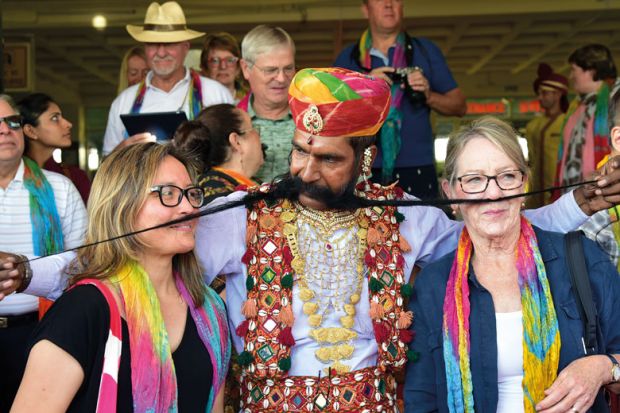The plan for India to open its higher education sector to leading global universities, as outlined in the new National Education Policy (NEP), was always going to be met with a degree of scepticism.
The idea of welcoming branch campuses has been bogged down by political infighting for years, as the 2010 foreign education providers bill morphed into the 2012 foreign universities bill and was finally shelved when the government pivoted its attention to creating domestic “institutions of eminence”.
The latest provision for international universities is light on detail, stating that “those from among the top 100 universities in the world will be facilitated to operate in India”, and no draft legislation has been made public. But even if the idea falters again, at least the door has finally been opened after having been shut for more than a decade, experts said.
Arvind Panagariya, Jagdish N. Bhagwati professor of Indian political economy at Columbia University, cited a host of potential problems for international universities related to bureaucracy, hiring and finances. However, he told Times Higher Education, India was playing the long game.
“In India, change is always gradual,” he said. “It is possible that none of the top 100 universities will choose to come, especially if the implementing legislation puts too many restrictions on their entry. But we need to begin the process. If no universities choose to come, we will know that either barriers to entry are too high or that the top 100 institutions are not ready to come to India yet. Either way, we will know what to do next.”
Professor Panagariya said that compared with other industries, “higher education is one of the last sectors to be opened to foreign players”. Therefore, the move “is an extremely important and positive development”.
“Foreign universities will not only bring world-class education and educators to India, they can also be a catalyst to improvements in the quality of education in Indian institutions,” he said.
Philip Altbach, founding director of the Center for International Higher Education at Boston College, told THE that “allowing foreign universities to set up branch campuses in India is a big change and has long been discussed. However, the devil is in the detail.
“Policy seems to stipulate that only top-ranking foreign universities will be allowed – and it is unlikely that many, if any at all, would be willing to make the huge investments needed. And the earlier proposals of ‘terms and conditions’ for setting up branch campuses were problematic,” he said. “So in theory, this is a significant change, but in practice it is somewhat unlikely that there will be a surge of international action.”
Eldho Mathews, co-author with Professor Altbach of a recent paper on whether internationalisation could drive reform of higher education sectors, told THE that work was already under way to lay a foundation for change in India. For example, a feasibility study is being conducted by the state of Kerala on the establishment of an education hub with overseas institutions.
Dr Mathews, deputy adviser in the Unit for International Cooperation of the National Institute of Educational Planning and Administration in New Delhi, added that cooperation with world-class universities was not new, citing the Columbia University Global Center in Mumbai and the University of Chicago Center in Delhi. Harvard University’s India Research Center in Mumbai is deeply involved in public health issues, while the University of Pennsylvania’s Center for the Advanced Study of India has been in New Delhi since the early 1990s.
“The scope for joint programmes within the existing institutional framework is high,” he said. For example, several Indian Institutes of Technology (IITs) are already partnered with Australian universities.
Dr Mathews saw international campuses in India as a potential cost-friendly alternative for domestic and regional students. “A lot of Indian students who cannot afford education in the US, European countries, Canada, Australia, etc, tend to join foreign university branch campuses located in Singapore, Dubai, Malaysia, etc. Therefore, if international universities open branch campuses in India, they could attract Indian students and also students from other South Asian and African countries,” he said.
Students from these regions already dominate India’s international student market, which the government has been working to expand. In late July, the National Testing Agency rolled out a new exam for foreign students seeking scholarships at and admission to institutions in India. More than 5,000 students from 13 Asian and African countries took the first Indian Scholastic Assessment, which may be expanded after its successful pilot.
The NEP states that India will be promoted as a global study destination, and that international student offices will be opened at each hosting university. It also sets out provisions for Indian universities to open overseas branches, and says that research collaborations and student exchanges will be increased.
“We have a tendency to see international university presence only from the angle of branch campuses, but India offers a lot of other opportunities at different levels,” Dr Mathews said.
POSTSCRIPT:
Print headline: India’s formal invitation wins praise even if universities are yet to RSVP
Register to continue
Why register?
- Registration is free and only takes a moment
- Once registered, you can read 3 articles a month
- Sign up for our newsletter
Subscribe
Or subscribe for unlimited access to:
- Unlimited access to news, views, insights & reviews
- Digital editions
- Digital access to THE’s university and college rankings analysis
Already registered or a current subscriber? Login








